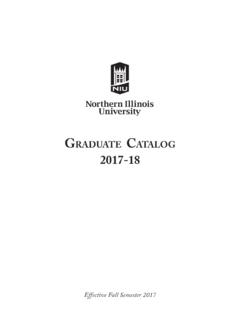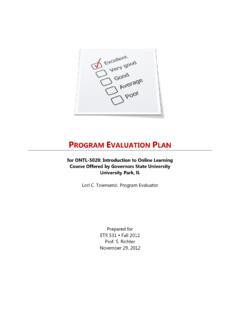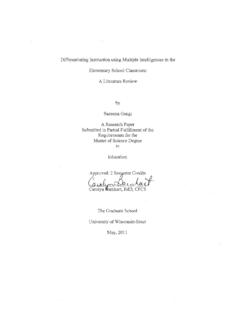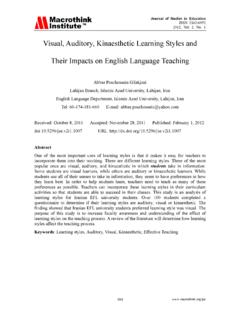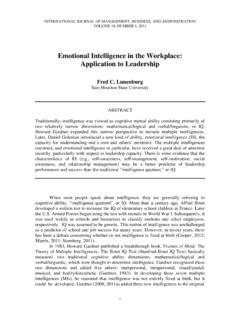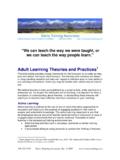Transcription of howard gardner’s theory of Multiple Intelligences
1 northern illinois university , Faculty Development and Instructional Design Center , howard gardner s theory of Multiple Intelligences Many of us are familiar with three general categories in which people learn: visual learners, auditory learners, and kinesthetic learners. Beyond these three general categories, many theories of and approaches toward human potential have been developed. Among them is the theory of Multiple Intelligences , developed by howard gardner , , Professor of Education at Harvard university . gardner s early work in psychology and later in human cognition and human potential led to the development of the initial six Intelligences . Today there are nine Intelligences and the possibility of others may eventually expand the list.
2 These Intelligences (or competencies) relate to a person s unique aptitude set of capabilities and ways they might prefer to demonstrate intellectual abilities. gardner s Multiple Intelligences 1. Verbal-linguistic intelligence (well-developed verbal skills and sensitivity to the sounds, meanings and rhythms of words) 2. Logical-mathematical intelligence (ability to think conceptually and abstractly, and capacity to discern logical and numerical patterns) 3. Spatial-visual intelligence (capacity to think in images and pictures, to visualize accurately and abstractly) 4. Bodily-kinesthetic intelligence (ability to control one s body movements and to handle objects skillfully) 5. Musical Intelligences (ability to produce and appreciate rhythm, pitch and timber) 6.
3 Interpersonal intelligence (capacity to detect and respond appropriately to the moods, motivations and desires of others) 7. Intrapersonal (capacity to be self-aware and in tune with inner feelings, values, beliefs and thinking processes) 8. Naturalist intelligence (ability to recognize and categorize plants, animals and other objects in nature) 9. Existential intelligence (sensitivity and capacity to tackle deep questions about human existence such as, What is the meaning of life? Why do we die? How did we get here? (Source: Thirteen ed online, 2004) Human Potential Human potential can be tied to one s preferences to learning; thus, gardner s focus on human potential lies in the fact that people have a unique blend of capabilities and skills ( Intelligences ).)
4 This model can be used to understand overall personality, preferences and strengths ( , ). gardner asserts that people who have an affinity toward one of the Intelligences do so in concert with the other Intelligences as they develop skills and solve problems ( , 2009). Human potential can be tied to one s preferences to howard gardner S theory OF Multiple Intelligences Page | 2 northern illinois university , Faculty Development and Instructional Design Center , People have different strengths and Intelligences . For example, students who are interviewed as a means to gain access to a course may be mis-labeled as being less than desirable because of inappropriate assessment (poorly written interview questions, bias toward a perceived perfect student, and other narrow criteria).
5 In life, we need people who collectively are good at different things. A well-balanced world, and well-balanced organizations and teams, are necessarily comprised of people who possess different mixtures of Intelligences . This gives that group a fuller collective capacity than a group of identical able specialists ( , 2009). gardner s Multiple Intelligences theory can be used for curriculum development, planning instruction, selection of course activities, and related assessment strategies. Instruction which is designed to help students develop their strengths can also trigger their confidence to develop areas in which they are not as strong. Students Multiple learning preferences can be addressed when instruction includes a range of meaningful and appropriate methods, activities, and assessments.
6 Summary In summary, integrate educational theories, teaching strategies, and other pedagogic tools in meaningful and useful ways to better address the needs of students. gardner himself asserts that educators should not follow one specific theory or educational innovation when designing instruction but instead employ customized goals and values appropriate to their teaching and student needs. Addressing the Multiple Intelligences and potential of students can help instructors personalize their instruction and methods of assessment. gardner s Multiple Intelligences Table 1 below highlights the primary seven Intelligences with further details on their attributes. Refer to this chart as you prepare instruction, related activities, and assessments.
7 Adapted from (2009) Instruction which is designed to help students develop their strengths can also trigger their confidence to develop areas in which they are not as strong. howard gardner S theory OF Multiple Intelligences Page | 3 northern illinois university , Faculty Development and Instructional Design Center , Table 1 LINGUISTIC intelligence Learning style and preferences Description Roles Tasks, activities and assessments Words and language written and spoken words interpretation and explanation of ideas and information via language understands relationship between communication and meaning copywriters editors historians journalists lawyers linguists poets PR and media consultants speakers teachers professors trainers translators TV and radio presenters voice-over artists writer edit a peer s paper give an oral presentation list the strengths and weaknesses of a product write a eulogy write directions to accompany a map howard gardner S theory OF Multiple Intelligences Page | 4 northern illinois university .
8 Faculty Development and Instructional Design Center , LOGICAL-MATHEMATICAL intelligence Learning style and preferences Description Roles Tasks, activities and assessments Logic and numbers analyze problems detecting patterns perform mathematical calculations scientific reasoning and deduction understands relationship between cause and effect toward a tangible outcome or result analysts arbitrators bankers certified public accountants computer programmers accountants engineers insurance brokers negotiators researchers scientists statisticians traders analyze how a computer works assess the value of a business or a proposition create a process devise a strategy to achieve an aim perform a mental mathematical calculation.
9 Create a process to measure something howard gardner S theory OF Multiple Intelligences Page | 5 northern illinois university , Faculty Development and Instructional Design Center , MUSICAL intelligence Learning style and preferences Description Roles Tasks, activities and assessments Music, sound, rhythm awareness, appreciation and use of sound recognition of tonal and rhythmic patterns understands relationship between sound and feeling acoustic engineers composers DJs entertainers environment and noise analysts music producers musical instrument repair specialists musical performers singers voice coaches coach someone to play a musical instrument compose media jingles identify music for malls and retail stores lead a choir perform a musical piece review a musical play whistle a tune howard gardner S theory OF Multiple Intelligences Page | 6 northern illinois university , Faculty Development and Instructional Design Center.
10 BODILY KINESTHETIC intelligence Learning style and preferences Description Roles Tasks, activities and assessments Body movement control eye and body coordination manual dexterity physical agility and balance anthropologists athletes biologists dancers geologists instrumentalists nurses physical education teachers physical therapists physicians actors sign-language interpreters arrange workplace furniture demonstrate a sports technique design a window display interpret a speech using American sign language prepare samples for magnification and testing put together a piece of modular furniture ride a horse stack books on a shelf howard gardner S theory OF Multiple Intelligences Page | 7 northern illinois university .





